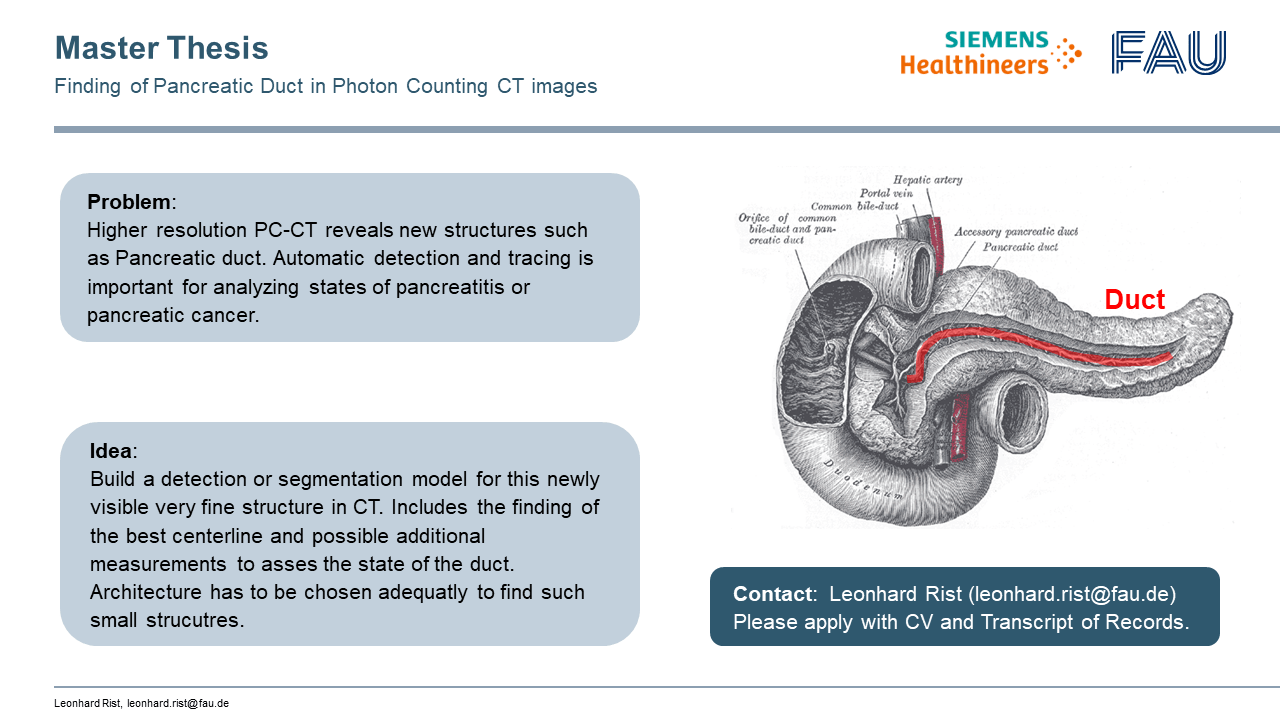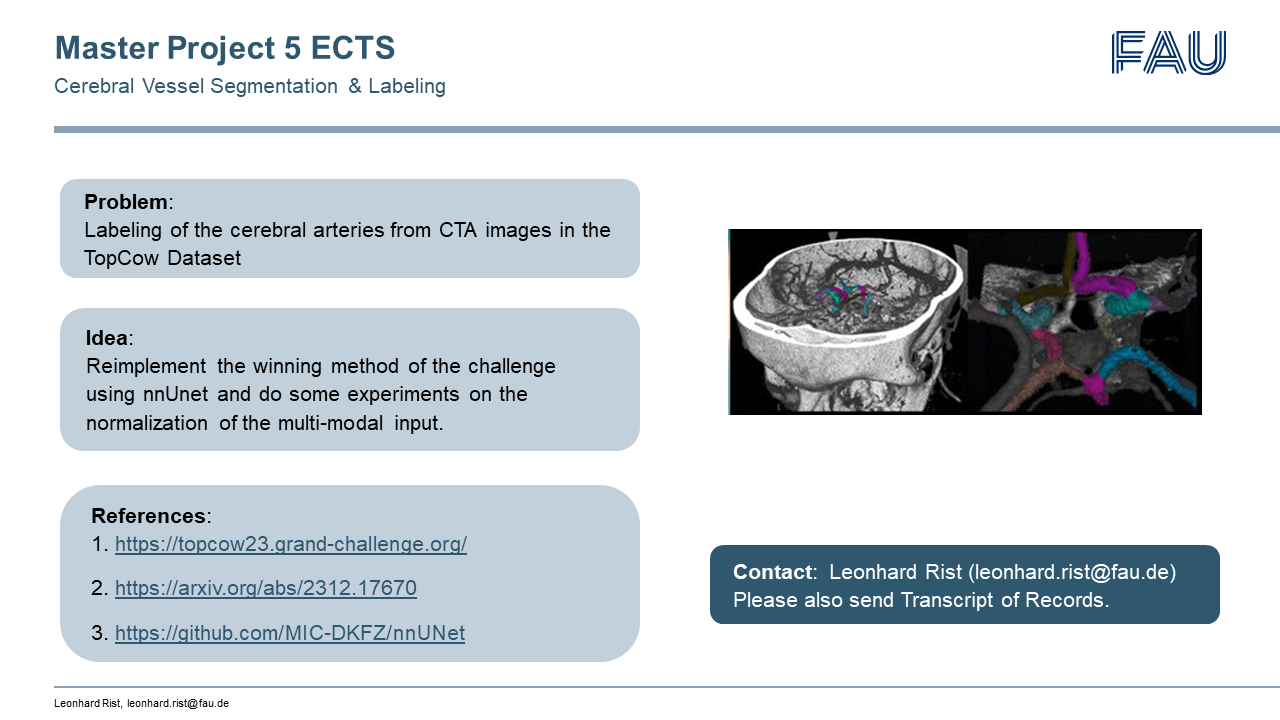Index
Detection of Pancreatic Duct in Computed Tomography

Volumetric Cerebral Vessel Labeling

Advanced Machine Learning Techniques for Data-Driven Monitoring of Coil Winding Processes in Electric Motor Manufacturing
Numerous industrial processes generate process data that can offer valuable insight into the manufacturing process. These datasets may include different types of information, such as temperature profiles, pressure measurements, and force-time curves, all of which are essential to understanding the dynamic nature of industrial processes. Driven by this, the evaluation of sequential data, specifically time series data, through appropriate machine learning (ML) techniques, particularly deep learning (DL), has gained significant attention. The possible applications of data-driven monitoring utilizing ML encompass detecting anomalies in manufacturing operations, predicting maintenance requirements to minimize downtime, optimizing production parameters for improved efficiency, and determining the resultant product quality.
The winding of coils is a fundamental process step in producing electric motors, generators, electromagnetic actuators, and transformers. The demand for these items, and consequently for coil winding, has increased with the transition to sustainable energy sources. DIN 8580 defines winding as the process of continuously bending the wire around a core part, such as a bobbin or stator tooth, to join them. For specific applications, especially small motors, the application of non-overlapping concentrated windings has become a common practice. The windings are wrapped around one tooth per coil, which increases mass production capabilities and reduces the size of winding heads, in line with the requirements of the automotive industry. The needle winding technique is widely adopted for producing concentrated windings in laminated cores of entire stators. The automated process performs both winding and coil joining. However, monitoring the stochastic process of needle winding presents a challenge due to numerous variables that can impact it.
In the early stages, Bosch, our industrial partner, upgraded certain winding machines to record all process data that could be important for monitoring purposes. This includes force, torque, and position curves, as well as additional tabular data such as wire length and stator tooth height. Initial attempts to predict the resulting quality of coils based on this data have shown basic potential but have been limited by small amounts of data and comparatively simple ML techniques. With the expansion of the database, our data-driven approach to process monitoring shall be further developed by incorporating more advanced ML/DL techniques. Thus far, limited research has been conducted on the implementation of ML or DL techniques for monitoring manufacturing processes using time series data, as the bulk of previous studies concentrated on time series forecasting for predictive maintenance use, rather than time series classification/regression and anomaly detection for the monitoring of manufacturing processes.
Overall, this thesis aims to develop a monitoring technique powered by data and employing advanced ML methods. The primary objective is to detect anomalies in the coil winding process, which will initiate a comprehensive process monitoring. This will enable engineers to optimize the manufacturing process. Anomaly detection serves two crucial purposes: accurately identifying established fault patterns and detecting previously unseen faults that may have evaded end-of-line testing. Detecting fault patterns reliably significantly improves overall product quality. One objective is to analyze the challenges that arise during the needle winding process and the factors that contribute to these difficulties. This involves using the winding machine’s control signals to assess the ongoing winding stages and detect sources of errors. Another objective is to determine how to handle various product types and machine configurations appropriately. A further objective is to select an appropriate ML or DL model by investigating different data preparation techniques. We plan to identify the best ML method through careful analysis and the establishment of a preliminary standard. A combination of models will also be considered. The final objective is to prototypically integrate the model into the ongoing production process and evaluate its effectiveness in a real-time operational setting. Through all this, we aim to demonstrate the potential of a ML/DL technique for data-based monitoring of coil winding procedures in the production of electric motors. This will enhance the quality of the process, provide valuable process insights, and reduce overall costs.
Brain Tumor Segmentation with Focus on Complex Subregions
Comparative analysis of word representations in LLMs using BERT and LSTM architecture
Exploring Narrative Representations in the Large Language Model BERT
Leakage Detection and Modeling in Water Distribution Systems
Abstract:
Leakage within Water Distribution Networks (WDNs) constitutes a primary concern for utilities, significantly impacting water conservation and the ability to meet consumer demand. In addressing this pervasive issue, the present study explores the efficacy of a comprehensive detection and localization strategy across District Meter Areas (DMAs). The research hinges on the development of a calibrated hydraulic model that adheres to stringent standards, minimizing error margins and setting a precedent in the domain of water network analysis. Central to the study is the implementation of an autoencoder-based deep learning framework, which has demonstrated proficiency in the detection of leaks. To transcend the limitations imposed by sparse sensor networks, a novel hybrid approach was adopted, integrating the hydraulic model with data-driven algorithms to enhance the localization of leaks. The methodology involved segmenting the DMA into subzones and applying rolling window simulations to create a diverse dataset for training a Convolutional Neural Network (CNN). The standout performance of the model, particularly with a 6-hour rolling window, was corroborated by its ability to precisely localize leaks in an actual case scenario. Addressing this issue, our research advances a strategy for leak detection and localization that is both economical and effective, utilizing minimal sensor input and also the importance of additional sensors to localize leak even more accurately. The implications of this research extend towards reinforcing the operational integrity of WDNs, fostering water conservation, and ensuring resource availability and sustainability in the face of escalating demand.
Keywords: Water Distribution Networks, Hydraulic Modelling, Data-Driven Methods, Spectral Clustering, Leakage Detection, Leakage Localization.
This thesis is part of the “UtilityTwin” project.
Adaptive Training for Heat Demand Prediction of District Heating Network
In this thesis, we focus on short-term heat demand forecasting based on measured consumer demand. The thesis also studies approaches from Continual Learning, for developing an adaptive forecasting framework to deploy at the energy supplier to optimize supply and demand.
Heat Demand Forecasting with Multi-Resolutional Representation of Heterogeneous Temporal Ensemble
Abstract:
One of the primal challenges faced by utility companies is ensuring efficient supply with minimal greenhouse gas emissions. The advent of smart meters and smart grids provide an unprecedented advantage in realizing an optimized supply of thermal energies through proactive techniques such as load forecasting. In this research thesis, we propose a deep learning-based forecasting framework for heat demand based on neural networks where the time series are represented as scalograms equipped with the capacity of embedding exogenous variables such as weather, and holiday/non-holiday. Subsequently, CNNs are utilized to predict the heat load multi-step ahead. Finally, the proposed framework is compared with other state-of-the-art methods, such as SARIMAX and LSTM, and two variants of the proposed method.
The quantitative results from retrospective experiments show that the proposed framework consistently outperforms the state-of-the-art baseline method with real-world data acquired from Denmark. A minimal mean error of 7.69% for Mean Absolute Percentage Error and 202.80kW for Root Mean Squared Error is achieved with the proposed framework in comparison to all other methods. Moreover, the proposed method exhibits minimal deviation of performance across different climatic seasons and geographical zones compared to the baseline methods.
This thesis is part of the “UtilityTwin” project.
Graph Neural Networks in Pathological Speech
Apply Graph knowledge to applications on pathological speech (e.g., Parkinson’s disease).
Pre-requirements:
- Pattern Analysis
- Deep Learning
- Optional: Speech and Language Understanding
- Optional: Seminar on pathological speech
Please send your grades to paula.andrea.perez@fau.de and luis.rivera@fau.de